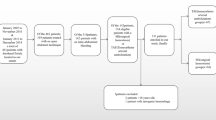Abstract
Purpose
To evaluate the safety, efficacy, and feasibility of transcatheter arterial embolization (TAE) in the treatment of lower gastrointestinal bleeding (LGIB).
Methods
Study group comprised all patients receiving angiography for LGIB in the Helsinki University Hospital during the period of 2004–2016. Hospital medical records provided the study data. Rebleeding, complication, and mortality rates (≤ 30 days) were the primary outcomes. Secondary outcomes included need for blood transfusions, durations of intensive care unit and hospital admissions, incidence of delayed rebleeding, and long-term complications, as well as overall survival.
Results
During the study period, angiography for LGIB was necessary on 123 patients. Out of 123, 55 (45%) underwent embolization attempts. TAE was technically successful in 53 (96%). Rebleeding occurred in 14 (26%). The complication rate was 36%, minor complications occurring in 10 (19%) and major in nine (17%). Major complications resulted in bowel resection in seven (13%). Post embolization ischemia was the most common single complication seen in nine (17%). The mortality rate was 6%. Survival estimates of 1 and 5 years were 79 and 49%.
Discussion
LGIB is a severe physiological insult occurring in patients who are often elderly and moribund. Although major post embolization complications occur, transcatheter arterial embolization should be the first-line approach over surgery in profuse LGIB in patients with hemodynamic instability, when colonoscopy fails or is unavailable, or when computerized tomography angiography detects small intestinal bleeding.



Similar content being viewed by others
References
Strate LL. Lower GI Bleeding: Epidemiology and diagnosis. Gastroenterology Clinics of North America. 2005;34(4):643–64.
Zuccaro G. Epidemiology of lower gastrointestinal bleeding. Best Pract Res Clin Gastroenterol. 2008;22(2):225–32.
Strate LL, Gralnek IM. ACG clinical guideline: Management of patients with acute lower gastrointestinal bleeding. Am J Gastroenterol. 2016;111(4):459–74.
Pasha SF, Shergill A, Acosta RD, Chandrasekhara V, Chathadi KV, Early D, et al. The role of endoscopy in the patient with lower GI bleeding. Gastrointest Endosc. 2014;79(6):875–85.
Lhewa DY. Pros and cons of colonoscopy in management of acute lower gastrointestinal bleeding. World J Gastroenterol. 2012;18(11):1185–6.
Marion Y, Lebreton G, Le Pennec V, Hourna E, Viennot S, Alves A. The management of lower gastrointestinal bleeding. J Visc Surg. 2014;151(3):191–201.
Walker TG. Angiographic evaluation and management of acute gastrointestinal hemorrhage. World J Gastroenterol. 2012;18(11):1191–11.
Angle JF, Siddiqi NH, Wallace MJ, Kundu S, Stokes LA, Wojak JC, et al. Quality improvement guidelines for percutaneous transcatheter embolization. J Vasc Interv Radiol. 2010;21(10):1479–86.
Bua-ngam C, Norasetsingh J, Treesit T, Wedsart B, Chansanti O, Tapaneeyakorn J, et al. Efficacy of emergency transarterial embolization in acute lower gastrointestinal bleeding: A single-center experience. Diagn Interv Imaging. 2017;98(6):499–505.
Hur S, Jae HJ, Lee M, Kim H-C, Chung JW. Safety and efficacy of transcatheter arterial embolization for lower gastrointestinal bleeding—A single-center experience with 112 patients. J Vasc Interv Radiol. 2014;25(1):10–9.
Teng H-C, Liang H-L, Lin Y-H, Huang J-S, Chen C-Y, Lee S-C, et al. The Efficacy and long-term outcome of microcoil embolotherapy for acute lower gastrointestinal bleeding. Korean J Radiol. 2013;14(2):259–10.
Huang CC, Lee CW, Hsiao JK, Leung PC, Liu KL, Tsang YM, et al. N-butyl cyanoacrylate embolization as the primary treatment of acute hemodynamically unstable lower gastrointestinal hemorrhage. J Vasc Interv Radiol. 2011;22(11):1594–9.
Gillespie CJ, Sutherland AD, Mossop PJ, Woods RJ, Keck JO, Heriot AG. Mesenteric embolization for lower gastrointestinal bleeding. Dis Colon Rectum. 2010;53(9):1258–64.
Maleux G, Roeflaer F, Heye S, Vandersmissen J, Vliegen A-S, Demedts I, et al. Long-term outcome of transcatheter embolotherapy for acute lower gastrointestinal hemorrhage. Am J Gastroenterol. 2009;104(8):2042–6.
Koh DC, Luchtefeld MA, Kim DG, Knox MF, Fedeson BC, VanErp JS, et al. Efficacy of transarterial embolization as definitive treatment in lower gastrointestinal bleeding. Colorectal Dis. 2009;11(1):53–9.
Tan K-K, Wong D, Sim R. Superselective embolization for lower gastrointestinal hemorrhage: An institutional review over 7 years. World J Surg. 2008;32(12):2707–15.
Lipof T, Sardella WV, Bartus CM, Johnson KH, Vignati PV, Cohen JL. The efficacy and durability of super-selective embolization in the treatment of lower gastrointestinal bleeding. Dis Colon Rectum. 2008;51(3):301–5.
Frodsham A, Berkmen T, Ananian C, Fung A. Initial experience using n-butyl cyanoacrylate for embolization of lower gastrointestinal hemorrhage. J Vasc Interv Radiol. 2009;20(10):1312–9.
Gupton T, Cura M. The case for computed tomographic angiography for initial management of lower gastrointestinal hemorrhage. Baylor University Medical Center Proceedings. 2017;30(3):353–4.
Acknowledgements
The authors would like to thank statistician Harri Mustonen for his valuable advice and comments.
Grant Support
Helsinki University Hospital Research Fund
Pehr Oscar Klingendahl’s Fund
Waldemar von Frenckell’s Foundation
Finnish-Norwegian Medical Foundation
Author information
Authors and Affiliations
Contributions
Taina Nykänen (TN), Marianne Udd (MU) and Leena Kylänpää (LK) designed the study. Erno Peltola (EP) identified patients from the hospital registry. TN performed data collection and analysis. TN and EP drafted the manuscript while MU and LK provided supervision. All authors have critically commented the manuscript and approved the final version.
Corresponding author
Rights and permissions
About this article
Cite this article
Nykänen, T., Peltola, E., Kylänpää, L. et al. Transcatheter Arterial Embolization in Lower Gastrointestinal Bleeding: Ischemia Remains a Concern Even with a Superselective Approach. J Gastrointest Surg 22, 1394–1403 (2018). https://doi.org/10.1007/s11605-018-3728-7
Received:
Accepted:
Published:
Issue Date:
DOI: https://doi.org/10.1007/s11605-018-3728-7




